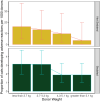Feline blood donation: Description and adverse reactions from 29 201 donation events between 2019 and 2023
- PMID: 39394936
- PMCID: PMC11586546
- DOI: 10.1111/jvim.17215
Feline blood donation: Description and adverse reactions from 29 201 donation events between 2019 and 2023
Erratum in
-
Erratum for "Feline Blood Donation: Description and Adverse Reactions From 29 201 Donation Events Between 2019 and 2023".J Vet Intern Med. 2025 Jul-Aug;39(4):e70194. doi: 10.1111/jvim.70194. J Vet Intern Med. 2025. PMID: 40711499 Free PMC article. No abstract available.
Abstract
Background: Feline blood transfusion is required for the treatment of various illnesses in cats, and the safety of donor cats is vital. Donor adverse reactions can include cardiorespiratory, venepuncture-related, and behavioral abnormalities.
Hypothesis/objectives: To describe a large number of feline blood donation events and document use of sedation and anxiolysis, record volume of blood collected and describe the frequency, type, and risk factors for, adverse reactions.
Animals: The study included 7812 individual cats and 29 201 donation events at a blood banking center over 5 years.
Methods: Retrospective analysis of donation event records with signalment, donation volume, sedation status, donation number, and adverse reactions (acute and caregiver reported) recorded. Risk factors for adverse reactions were examined by stratifying data according to groups exposed to relevant predictors and calculating odds ratios with 95% and 99% confidence intervals (CIs).
Results: Adverse reactions were uncommon (0.29%, 2.88/1000 donor events) and most commonly were cardiorespiratory (0.08%, 0.75/1000 donor events) or behavioral (0.06%, 0.62/1000 donor events). The only risk factor significantly associated with adverse reactions was conscious donation, with conscious donors 4.4 times more likely to have an adverse reaction (95% CI, 2.5-7.9, P ≤ .0001).
Conclusions and clinical importance: Feline blood donation is associated with a low rate of adverse reactions. Sedation should be considered to reduce adverse reactions, and the environment and interactions optimized to reduce donor stress. Caregiver education on care postdonation could reduce behavioral adverse reactions.
Keywords: anxiolysis; blood collection; blood donation; blood group; blood transfusion; cat; sedation.
© 2024 The Author(s). Journal of Veterinary Internal Medicine published by Wiley Periodicals LLC on behalf of American College of Veterinary Internal Medicine.
Conflict of interest statement
Authors declare no conflict of interest.
Figures





References
-
- Kuo KW, McMichael M. Small Animal Transfusion Medicine. Vet Clin North Am Small Anim Pract. 2020;50:1203‐1214. - PubMed
-
- Holowaychuk MKYK. Blood banking. In: Creedon JMB, ed. Advanced Monitoring and Procedures for Small Animal Emergency and Critical Care. West Sussex, UK: Wiley‐Blackwell; 2023:905‐920.
-
- Taylor RK, Humm K. Feline blood collection. In: Holowaychuk M, Yagi K, eds. Manual of Veterinary Transfusion Medicine and Blood Banking. Sussex, UK: Wiley Blackwell; 2016:223‐236.
-
- Wilder A, Humm K. Pet owners' awareness of animal blood banks and their motivations towards animal blood donation. Vet Rec. 2019;185:509. - PubMed
MeSH terms
LinkOut - more resources
Full Text Sources
Medical
Miscellaneous

